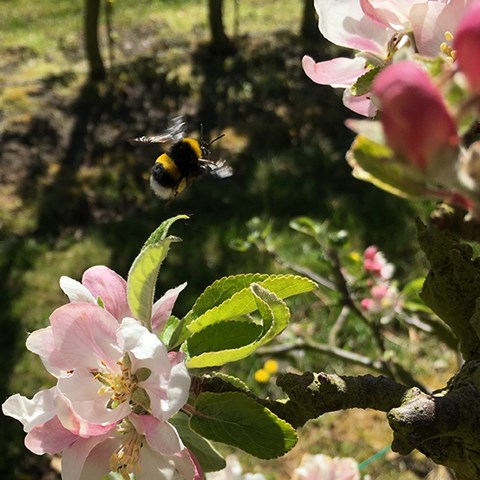Contact
Department of Ecology, NJ, Agricultural Entomology Unit

Tighter regulations within the EU should protect pollinators from pesticides used in agriculture. However, a major field study involving bumblebees placed in apple orchards and rapeseed crops across eight countries shows that the current risk assessment is still inadequate. The greater the amount and toxicity of the pesticides that were encountered by the bumblebees, the worse off the colonies were—they produced fewer new bumblebees.
The study, recently published in the journal Nature, involved researchers from Lund University and the Swedish University of Agricultural Sciences (SLU) in collaboration with seven other countries: Estonia, the UK, Ireland, Italy, Spain, Germany and Switzerland. In each of these countries, the researchers placed three colonies of buff-tailed bumblebees at 128 sites. These included oilseed rape and apple orchards in different climatic zones. The sites were also chosen based on different landscapes, ranging from heavily dominated agricultural areas to those with more natural environments such as pastures and forests.
A fascinating aspect of this study is its perspective from the bumblebees' point of view. The researchers analysed the pollen collected by the bumblebees to determine its source (flowers) and the pesticides it contained. On average, pollen from a single colony contained eight different pesticides targeting weeds, insects and fungi. Of these, insecticides posed by far the greatest risk to bumblebees, even though the most commonly used pesticides were fungicides or herbicides. The researchers used databases to estimate the combined risk of all the pesticides to which bumblebees were exposed at each site.
To evaluate well-being of the bumblebees, the researchers weighed the colonies before, during and after the flowering season. Weight reflects the number of new offspring produced. Thirteen percent of the colonies were heaviest at the start of the season, suggesting that the number of individuals decreased rather than increased over the summer. At the end of the season, the researchers froze the colonies and counted the number of cocoons to measure the total number of bumblebees produced.
The results clearly demonstrate that both the number of cocoons and the weight of the colonies were lower when the bumblebees' pollen contained higher levels of risky pesticides. In other words, colony growth appears to be negatively affected by pesticides.
Sixty percent of the colonies did not meet the current EU target of no more than 10% negative impact on bumblebee colonies. The risk and negative impact on bumblebees decreased in more diverse landscapes with less agriculture and more natural environments.
"Despite claims of the world's most rigorous risk assessment process, the use of approved pesticides in European agricultural landscapes still negatively affects non-target organisms. We hope our study will be used to strengthen protection for bumblebees and other pollinators," says Maj Rundlöf, researcher at Lund University who led the study.
The study is part of an EU project called POSHBEE, coordinated in Sweden by Joachim de Miranda at SLU. It focuses on different aspects of honeybee and wild bee health, such as diseases, pesticides and nutrition.
"Today, a risk assessment largely finishes when a pesticide is either approved or not, and is mostly based on how much pesticide is applied in the fields. Our research shows that there also needs to be a post-approval monitoring phase, in real-world situations, using a risk assessment strategy based on the bees actual exposure risk, through the pollen and nectar they collect . The same method that we used—placing sentinel bumblebee colonies across Europe—can be employed in that process. We've estimated that less than half of the number bumblebee colonies we used in our experiments would be needed to obtain similarly reliable results," says Joachim de Miranda."
Pesticide use negatively affects bumble bees across European landscapes, Nature, Nicholson et al